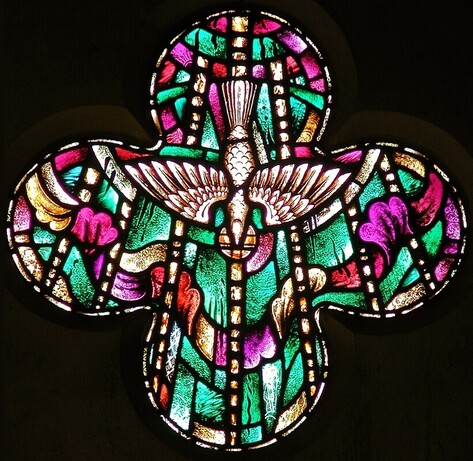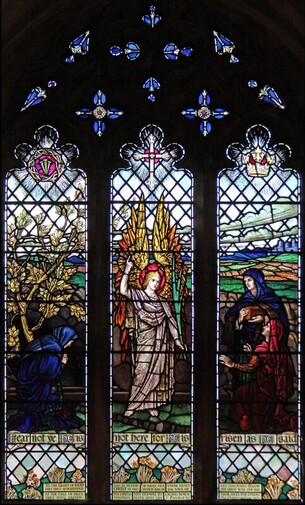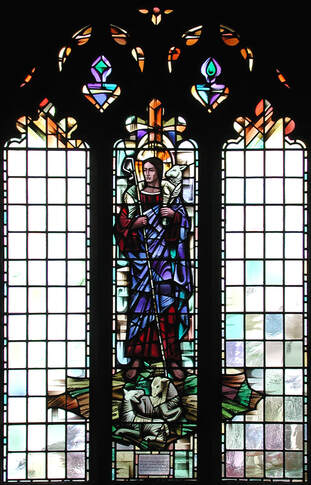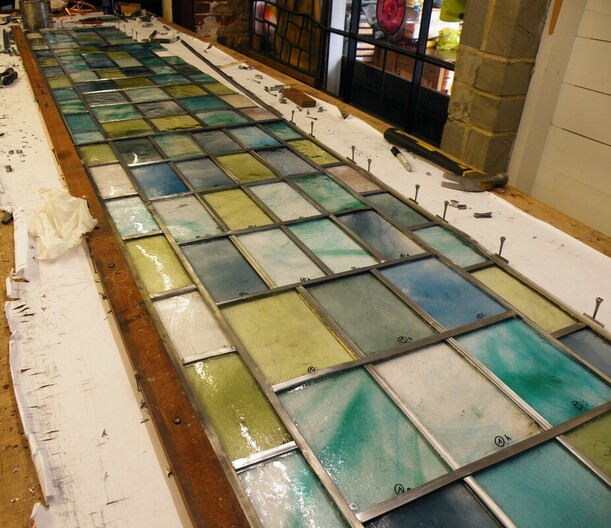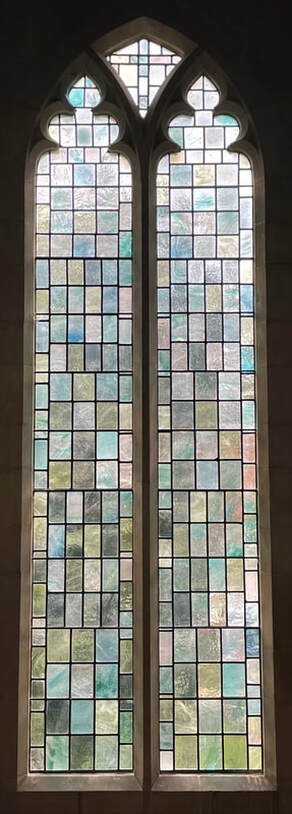Whitefriars Glass at St George's, Headstone
The long-established and renowned glass-manufacturing firm of Powell & Sons (Whitefriars), formerly known as James Powell & Sons, moved from the City of London to new premises in Wealdstone near Harrow in 1923. Adopting the hooded friar logo, the firm changed its name to Whitefriars Glass in 1962. Whitefriars produced stained glass windows until 1973; the factory closed completely in 1980. The Whitefriars glass at St George's was installed over a period spanning more than ninety years.
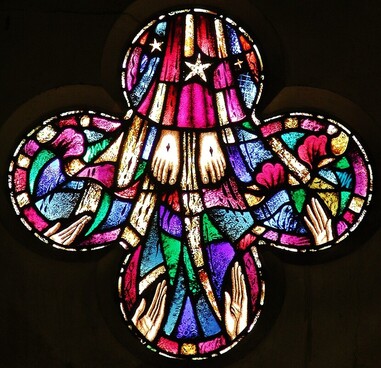 Ascension of Christ by E Liddall Armitage
Ascension of Christ by E Liddall Armitage
Angel and Women at the Empty Tomb by William Aikman
After serving his apprenticeship with Ballantyne of Edinburgh, from 1892 William Aikman (1868-1959) was employed by James Powell and Sons as glass-painter and occasional designer. His work for the firm included the execution of windows designed by W B Richmond for St Paul’s Cathedral; sadly these were all destroyed in the Second World War. William Aikman set up independently in 1913. He also taught at the Camberwell College of Arts and Crafts where his most notable pupil was James Hogan – later chief designer and art director at Powell & Sons (Whitefriars).
Aikman’s resurrection-themed window in the Lady Chapel at St George’s is a memorial to members of the congregation who died in the Great War. It was unveiled by Sir Philip Lloyd Graeme, KBE, MP, in 1921. Art historian Peter Cormack comments ‘His windows are always beautifully painted. The window at St George’s is a characteristic example of Aikman’s use of rich colours – in the figure subjects – combined with quarry glazing in "streaky" white glass. The glass itself is of the very highest quality, doubtless made by Powell & Sons (Whitefriars)’.
Descent of the Holy Dove and Ascension of Christ by E Liddall Armitage
E Liddall Armitage (1887-1967) was an assistant to Karl Parsons before working on his own account and with Henry Holiday. He joined Powell & Sons (Whitefriars) around 1940, becoming chief designer around 1963. His quatrefoil windows in the west wall of the nave at St Georges were installed in 1964 as a memorial to church member William Cowen Wilson. Peter Cormack says ‘they are rather unusual’ and ‘seem to reflect the very definite influence of the Hungarian Artist Erwin Bossanyi, who had connections with the Whitefriars studio’.
The studio’s description says that in the Descent of the Holy Dove at the Baptism of Christ window ‘the colouring suggests that of Springtime with life and hope surging to fulfilment. The time of fresh endeavour is also indicated by the rays of light, the highest thoughts and feelings breaking through the clouds of apathy into the routine of our mundane existence’. In the Ascension of Christ window ‘the colours are richer suggesting fulfilment and accomplishment which is visually manifest in the latter part of the yearly life cycle’.
After serving his apprenticeship with Ballantyne of Edinburgh, from 1892 William Aikman (1868-1959) was employed by James Powell and Sons as glass-painter and occasional designer. His work for the firm included the execution of windows designed by W B Richmond for St Paul’s Cathedral; sadly these were all destroyed in the Second World War. William Aikman set up independently in 1913. He also taught at the Camberwell College of Arts and Crafts where his most notable pupil was James Hogan – later chief designer and art director at Powell & Sons (Whitefriars).
Aikman’s resurrection-themed window in the Lady Chapel at St George’s is a memorial to members of the congregation who died in the Great War. It was unveiled by Sir Philip Lloyd Graeme, KBE, MP, in 1921. Art historian Peter Cormack comments ‘His windows are always beautifully painted. The window at St George’s is a characteristic example of Aikman’s use of rich colours – in the figure subjects – combined with quarry glazing in "streaky" white glass. The glass itself is of the very highest quality, doubtless made by Powell & Sons (Whitefriars)’.
Descent of the Holy Dove and Ascension of Christ by E Liddall Armitage
E Liddall Armitage (1887-1967) was an assistant to Karl Parsons before working on his own account and with Henry Holiday. He joined Powell & Sons (Whitefriars) around 1940, becoming chief designer around 1963. His quatrefoil windows in the west wall of the nave at St Georges were installed in 1964 as a memorial to church member William Cowen Wilson. Peter Cormack says ‘they are rather unusual’ and ‘seem to reflect the very definite influence of the Hungarian Artist Erwin Bossanyi, who had connections with the Whitefriars studio’.
The studio’s description says that in the Descent of the Holy Dove at the Baptism of Christ window ‘the colouring suggests that of Springtime with life and hope surging to fulfilment. The time of fresh endeavour is also indicated by the rays of light, the highest thoughts and feelings breaking through the clouds of apathy into the routine of our mundane existence’. In the Ascension of Christ window ‘the colours are richer suggesting fulfilment and accomplishment which is visually manifest in the latter part of the yearly life cycle’.
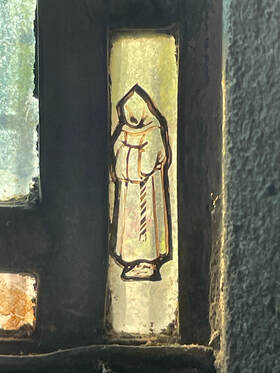 Friar logo in Alfred Fisher window
Friar logo in Alfred Fisher window
Christ the Good Shepherd by Alfred Fisher
Alfred Fisher joined Powell and Sons (Whitefriars) in 1951. In 1967 he succeeded E Liddall Armitage as chief designer. When Whitefriars closed its stained glass department Alfred Fisher founded Chapel Studio where, continuing to design extensively, he established a separate workshop for the conservation and repair of historic glass. After retiring from Chapel Studio he remained active as a designer, and also a conservation adviser working in collaboration with the National Trust and English Heritage.
Fisher’s 1965 Good Shepherd window, a memorial to St George’s member Wilfrid Barnes Barratt, is situated in the south aisle of the church. The side lights contain Whitefriars’ ‘Norman Slab’ glass. At the time of the commission budget constraints did not allow the tracery panels to be included in the scheme. Chapel Studio completed the window to a new design by Alfred Fisher in 2003 incorporating Whitefriars glass acquired when the firm closed its stained glass department and sold its stock.
Plain glazed Norman Slab windows
Completed and fitted in 2013, two windows at the west end of the aisles are made from Whitefriars Norman Slab, salvaged from St Martin-in-the-Fields, Westminster. Norman Slab was Whitefriars’ version of a type of glass much favoured during the Arts & Crafts period, produced by blowing into a square mould and cutting the sides of the resulting box into rectangles. The uneven slabs, which are thicker at the centre, refract light to brilliant effect.
Alfred Fisher joined Powell and Sons (Whitefriars) in 1951. In 1967 he succeeded E Liddall Armitage as chief designer. When Whitefriars closed its stained glass department Alfred Fisher founded Chapel Studio where, continuing to design extensively, he established a separate workshop for the conservation and repair of historic glass. After retiring from Chapel Studio he remained active as a designer, and also a conservation adviser working in collaboration with the National Trust and English Heritage.
Fisher’s 1965 Good Shepherd window, a memorial to St George’s member Wilfrid Barnes Barratt, is situated in the south aisle of the church. The side lights contain Whitefriars’ ‘Norman Slab’ glass. At the time of the commission budget constraints did not allow the tracery panels to be included in the scheme. Chapel Studio completed the window to a new design by Alfred Fisher in 2003 incorporating Whitefriars glass acquired when the firm closed its stained glass department and sold its stock.
Plain glazed Norman Slab windows
Completed and fitted in 2013, two windows at the west end of the aisles are made from Whitefriars Norman Slab, salvaged from St Martin-in-the-Fields, Westminster. Norman Slab was Whitefriars’ version of a type of glass much favoured during the Arts & Crafts period, produced by blowing into a square mould and cutting the sides of the resulting box into rectangles. The uneven slabs, which are thicker at the centre, refract light to brilliant effect.
At the suggestion of Peter Cormack the slab glass was cut and leaded to a design by Christopher Whall, published in 1900. In the words of Holy Well Glass, who undertook the work, ‘the leaded lights are beautiful and hugely successful, emphasising the importance of good design, and the best materials for the production of plain glazing’.

